Visual Basic program "VB BHmerger" - Display - BH #3 = 5 m0
When you observe the above merger displays there two distinct types:
- In the first type you see many black "circles". A typical one is display #1 with phi = 0.
- In the second type you observe many red "circles". A typical one is display #20 with phi = 190.
In each of the displays there is also a green line. This is the path of the small object #3, which enters from the right and which approaches the binary pair of the two Black Holes.
The largest black hole is the black trajectory. This is BH #1. The path starts when phi is 0 left from the center of gravity and goes downwards.
The smallest black hole is the red trajectory. This is BH #2. Thi path starts when phi is 0 right from the center of gravity. The angle phi is angle between the start position of BH #2 and the horizontal point true the center of gravity. In the display the path goes upwards.
- In display #1 the black BH starts at phi = 180. Follows a circle through pi = 270 and meets the green BH at almost phi = 360 or 0 degrees. At that point the speed of BH #3 increases above 300000 km/sec and evaporates. That means the mass of BH #3 disintegrates and merges slowly with BH #1. The mass of BH #3 increases slowly and the two BH's start to spiral towards each other. This stops when all the mass of BH #3 has merged with BH #1 (the black one)
- In display #4 the black BH starts at phi = 210. Follows a circle through pi = 270 and meets the green BH at almost phi = 10 degrees. At that point the speed of BH #3 increases above 300000 km/sec and evaporates, the same as in picture #1. The difference between the two is that the closest distance is smaller and the rotation frequency of the two BH's is larger.
- In display #19 the red BH starts at phi = 180. Follows a circle through pi = 270 and meets the green BH at almost phi = 350 degrees. At that point the speed of BH #3 increases above 300000 km/sec and evaporates. That means the mass of BH #3 disintegrates and merges slowly with the red BH #2. The mass of BH #2 increases slowly and the two BH's start to spiral towards each other. This stops when all the mass of BH #3 has merged with BH #2 (the red one)
- In display 28 with phi 270 the green BH #3 is ejected from the binary system.
- Display 12, 18, 27 and 33 are typical cases where the average distance between the two BH #1 and #2, after the merging with the green BH #3, increases.
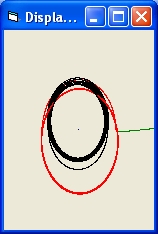 Picture 1
Phi 0
Picture 1
Phi 0
|
 Picture 2
Phi 10
Picture 2
Phi 10
|
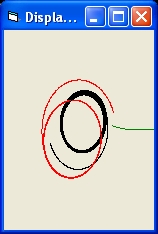 Picture 3
Phi 20
Picture 3
Phi 20
|
 Picture 4
Phi 30
Picture 4
Phi 30
|
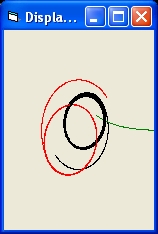 Picture 5
Phi 40
Picture 5
Phi 40
|
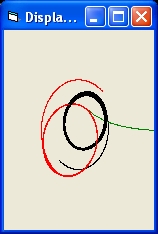 Picture 6
Phi 50
Picture 6
Phi 50
|
 Picture 7
Phi 60
Picture 7
Phi 60
|
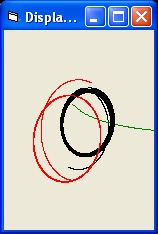 Picture 8
Phi 70
Picture 8
Phi 70
|
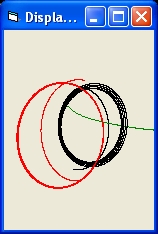 Picture 9
Phi 80
Picture 9
Phi 80
|
 Picture 10
Phi 90
Picture 10
Phi 90
|
 Picture 11
Phi 100
Picture 11
Phi 100
|
 Picture 12
Phi 110
Picture 12
Phi 110
|
 Picture 13
Phi 120
Picture 13
Phi 120
|
 Picture 14
Phi 130
Picture 14
Phi 130
|
 Picture 15
Phi 140
Picture 15
Phi 140
|
 Picture 16
Phi 150
Picture 16
Phi 150
|
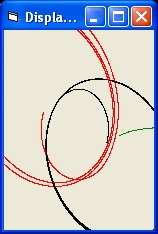 Picture 17
Phi 160
Picture 17
Phi 160
|
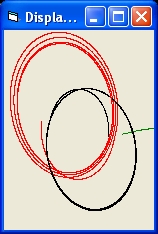 Picture 18
Phi 170
Picture 18
Phi 170
|
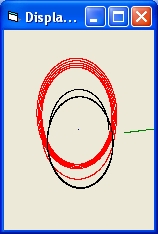 Picture 19
Phi 180
Picture 19
Phi 180
|
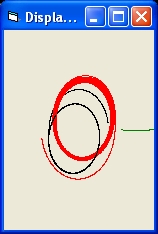 Picture 20
Phi 190
Picture 20
Phi 190
|
 Picture 21
Phi 200
Picture 21
Phi 200
|
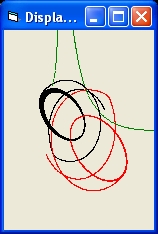 Picture 22
Phi 210
Picture 22
Phi 210
|
 Picture 23
Phi 220
Picture 23
Phi 220
|
 Picture 24
Phi 230
Picture 24
Phi 230
|
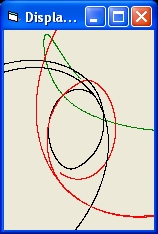 Picture 25
Phi 240
Picture 25
Phi 240
|
 Picture 26
Phi 250
Picture 26
Phi 250
|
 Picture 27
Phi 260
Picture 27
Phi 260
|
 Picture 28
Phi 270
Picture 28
Phi 270
|
 Picture 29
Phi 280
Picture 29
Phi 280
|
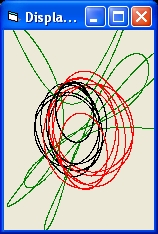 Picture 30
Phi 290
Picture 30
Phi 290
|
 Picture 31
Phi 300
Picture 31
Phi 300
|
 Picture 32
Phi 310
Picture 32
Phi 310
|
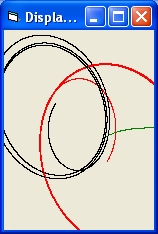 Picture 33
Phi 320
Picture 33
Phi 320
|
 Picture 34
Phi 330
Picture 34
Phi 330
|
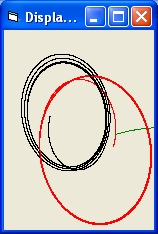 Picture 35
Phi 340
Picture 35
Phi 340
|
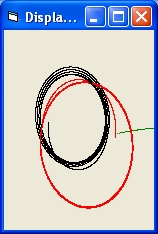 Picture 36
Phi 350
Picture 36
Phi 350
|
Created 3 March 2016
Back to my home page: VB BHmerger operation
Back to my home page: Contents of This Document







































































